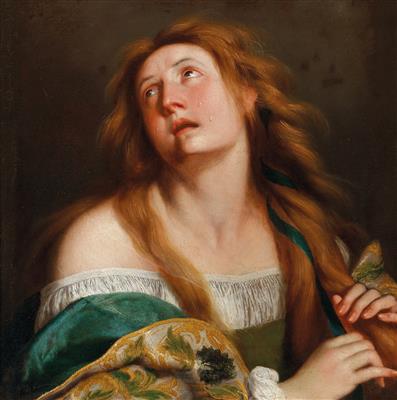Cesare Fracanzano

(Bisceglie 1605–1651 Barletta)
The Penitent Magdalene,
oil on canvas, 66 x 67 cm, framed
Literature:
G. Porzio, Cesare Fracanzano: un Compianto sul corpo di Abele e altre restituzioni al suo catalogo, in: Ricerche sull’arte a Napoli in età moderna. Scritti in onore di Giuseppe De Vito, Naples 2014, pp. 80–87, fig. 7 (as Cesare Fracanzano)
The attribution of the present painting has been independently confirmed by Riccardo Lattuarda, Gianni Papi and Giuseppe Porzio.
Despite his originality and considerable status in the Neapolitan school, surprisingly little is known about Francesco Fracanzano. He was born in Monopoli and was the son of Alessandro Fracanzano, a Veronese painter who was active in Apulia in the early seventeenth century. In 1622 Franco and his elder brother Cesare moved to Naples, where, according to Bernardo de Dominici, they trained at Jusepe de Ribera’s studio. In 1632 Franco married Giovanna, Salvator Rosa’s only sister. It is presumed that he fell victim to the plague of 1656. Fracanzano’s early style has been seen to evolve from the stimuli – and the most naturalistic phase – of (Riberesque) Neapolitan painting. But his paintings of the early 1630s demonstrate greater originality, a tension between the classicism of Ribera and a more ‘painterly’ style. His compositions of half-length figures (evocative also of the work of the anonymous Master of the Annunciations) are often densely realised on a generally dark ground, with brushstrokes sometimes loose and open like in the present painting, or at other times scumbled. They, as the present painting does, suggest knowledge, too, of the elegance, idealism and glowing colours of Van Dyck (1599–1641), whose work was prevalent in Naples at the time. Fracanzano’s capacity to morph and adapt his style is also evident in his work after 1640, prompting scholars to comment on its ‘involution’ – ‘a return to Ribera’, dramatic tenebrism and classicism. Dominici (1742) indicates that Fracanzano received illustrious private commissions from the Spanish viceroys: ‘Even the Duke of Campomele […] commissioned some paintings from Francesco for decorating his house’ (Bernardo de Dominici, Vite de’ Pittori, Scultori, ed Architetti Napolietani, vol. III, 1742).
Specialist: Dr. Alexander Strasoldo
 Dr. Alexander Strasoldo
Dr. Alexander Strasoldo
+43-1-515 60-556
old.masters@dorotheum.com
25.04.2017 - 18:00
- Estimate:
-
EUR 40,000.- to EUR 60,000.-
Cesare Fracanzano
(Bisceglie 1605–1651 Barletta)
The Penitent Magdalene,
oil on canvas, 66 x 67 cm, framed
Literature:
G. Porzio, Cesare Fracanzano: un Compianto sul corpo di Abele e altre restituzioni al suo catalogo, in: Ricerche sull’arte a Napoli in età moderna. Scritti in onore di Giuseppe De Vito, Naples 2014, pp. 80–87, fig. 7 (as Cesare Fracanzano)
The attribution of the present painting has been independently confirmed by Riccardo Lattuarda, Gianni Papi and Giuseppe Porzio.
Despite his originality and considerable status in the Neapolitan school, surprisingly little is known about Francesco Fracanzano. He was born in Monopoli and was the son of Alessandro Fracanzano, a Veronese painter who was active in Apulia in the early seventeenth century. In 1622 Franco and his elder brother Cesare moved to Naples, where, according to Bernardo de Dominici, they trained at Jusepe de Ribera’s studio. In 1632 Franco married Giovanna, Salvator Rosa’s only sister. It is presumed that he fell victim to the plague of 1656. Fracanzano’s early style has been seen to evolve from the stimuli – and the most naturalistic phase – of (Riberesque) Neapolitan painting. But his paintings of the early 1630s demonstrate greater originality, a tension between the classicism of Ribera and a more ‘painterly’ style. His compositions of half-length figures (evocative also of the work of the anonymous Master of the Annunciations) are often densely realised on a generally dark ground, with brushstrokes sometimes loose and open like in the present painting, or at other times scumbled. They, as the present painting does, suggest knowledge, too, of the elegance, idealism and glowing colours of Van Dyck (1599–1641), whose work was prevalent in Naples at the time. Fracanzano’s capacity to morph and adapt his style is also evident in his work after 1640, prompting scholars to comment on its ‘involution’ – ‘a return to Ribera’, dramatic tenebrism and classicism. Dominici (1742) indicates that Fracanzano received illustrious private commissions from the Spanish viceroys: ‘Even the Duke of Campomele […] commissioned some paintings from Francesco for decorating his house’ (Bernardo de Dominici, Vite de’ Pittori, Scultori, ed Architetti Napolietani, vol. III, 1742).
Specialist: Dr. Alexander Strasoldo
 Dr. Alexander Strasoldo
Dr. Alexander Strasoldo
+43-1-515 60-556
old.masters@dorotheum.com
|
Buyers hotline
Mon.-Fri.: 10.00am - 5.00pm
old.masters@dorotheum.at +43 1 515 60 403 |
| Auction: | Old Master Paintings |
| Auction type: | Saleroom auction |
| Date: | 25.04.2017 - 18:00 |
| Location: | Vienna | Palais Dorotheum |
| Exhibition: | 15.04. - 25.04.2017 |
